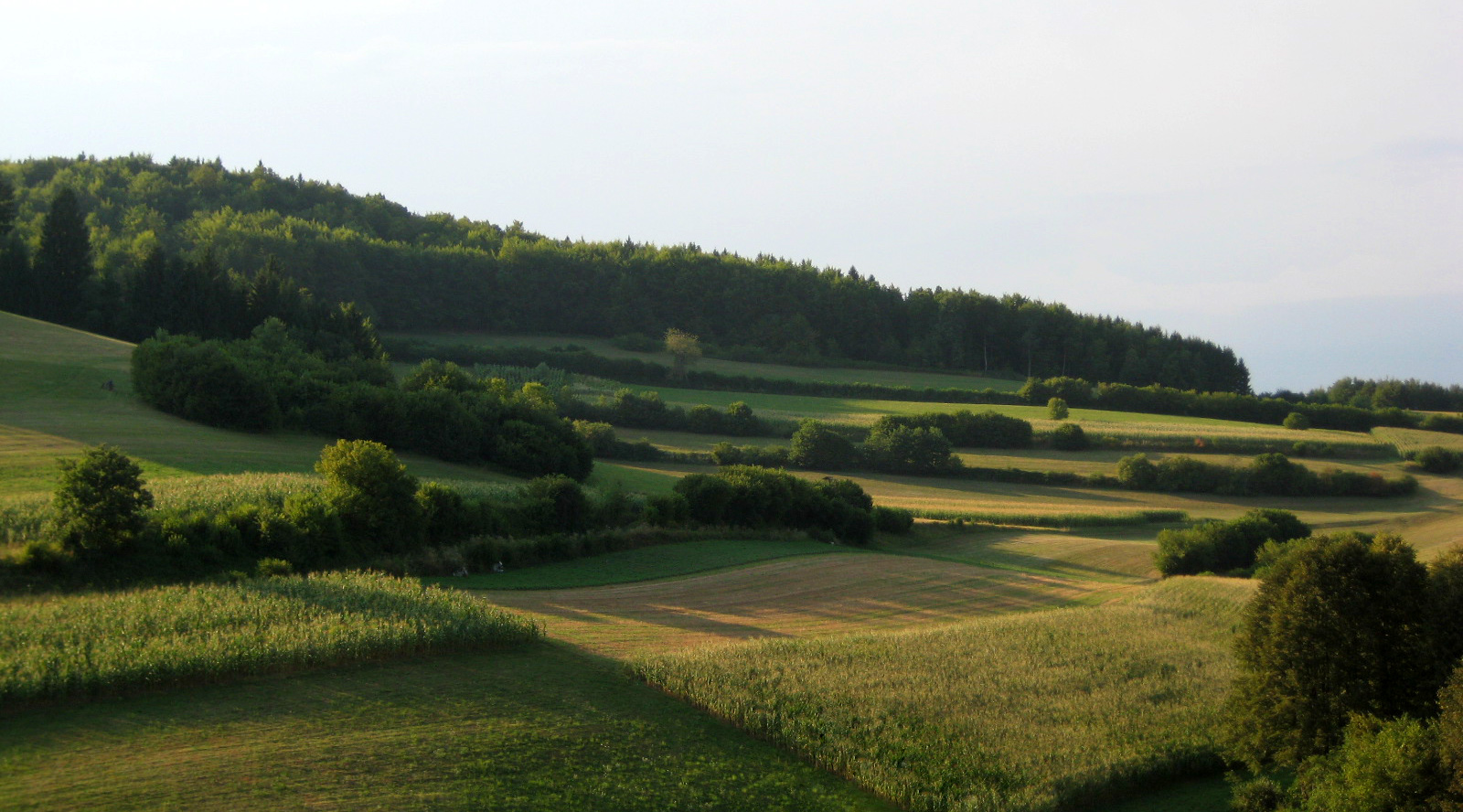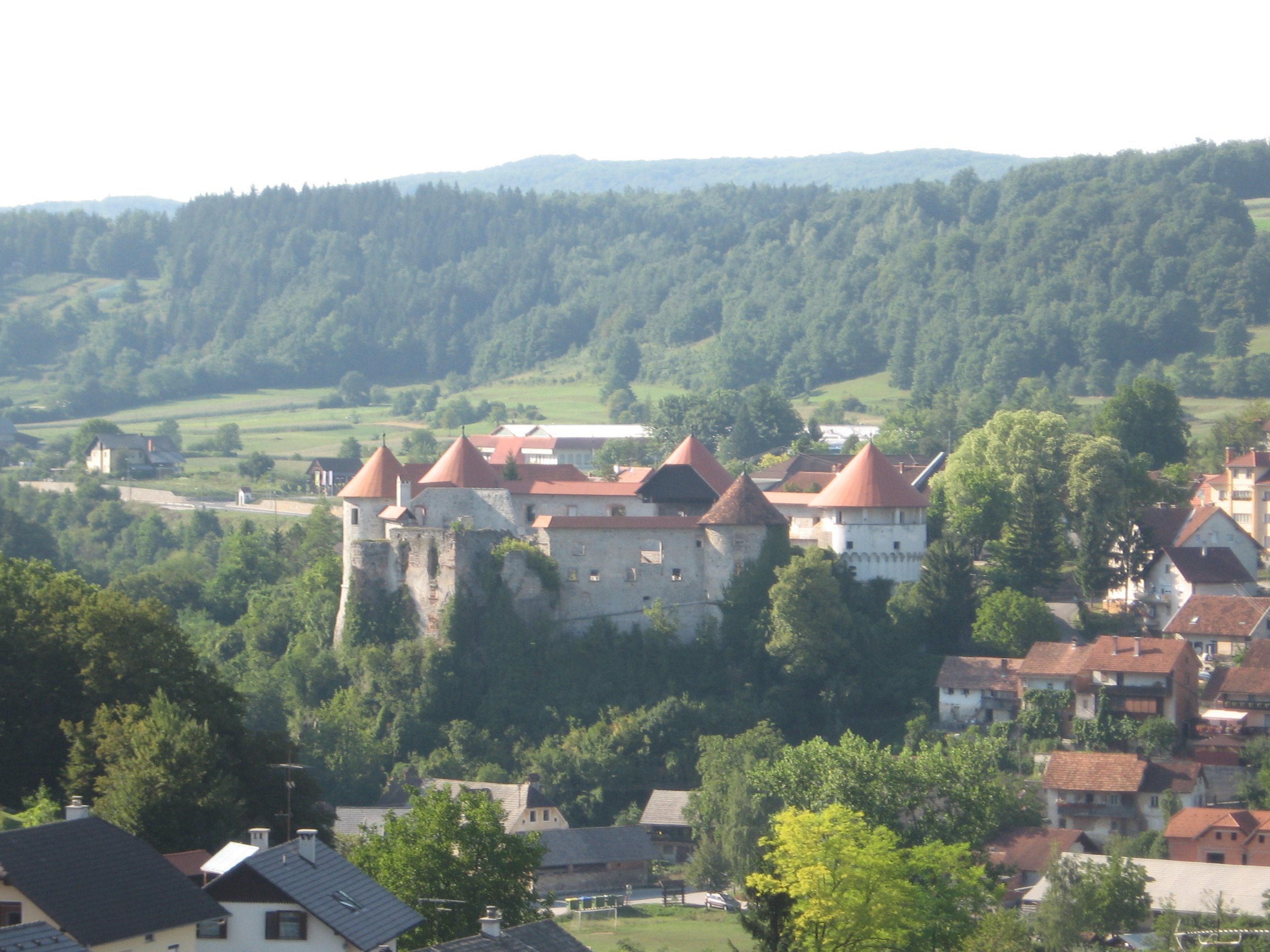|
Lopata, Žužemberk
Lopata (, german: Schaufel) is a village in the hills south of Žužemberk in southeastern Slovenia. The area is part of the historical region of Lower Carniola. The Municipality of Žužemberk is now included in the Southeast Slovenia Statistical Region. Name Lopata was attested in historical sources in 1423 as ''Schauffell'' (and as ''Schawfell'' in 1430 and ''Schawffell auff der Dueren Krain'' 'Schaufel in Dry Carniola' in 1463). These Middle High German names are believed to be translations of the Slovene name, which is derived from the common noun ''lopata'' (now 'shovel' but originally 'flat part/area'), referring to the level terrain of the village surrounded by hills. Church The local church is dedicated to Saint Agnes ( sl, sveta Neža) and belongs to the Parish of Hinje. It has a medieval nave The nave () is the central part of a church, stretching from the (normally western) main entrance or rear wall, to the transepts, or in a church without transepts, t ... [...More Info...] [...Related Items...] OR: [Wikipedia] [Google] [Baidu] |
Flag Of Slovenia
The national flag of Slovenia ( sl, zastava Slovenije) features three equal horizontal bands of white (top), blue, and red, with the Coat of arms of Slovenia located in the upper hoist side of the flag centered in the white and blue bands. The coat of arms is a shield with the image of Mount Triglav, Slovenia's highest peak, in white against a blue background at the center; beneath it are two wavy blue lines representing the Adriatic Sea and local rivers, and above it are three six-pointed golden stars arranged in an inverted triangle which are taken from the coat of arms of the Counts of Celje, the great Slovene dynastic house of the late 14th and early 15th centuries. The flag's colors are considered to be Pan-Slavism, Pan-Slavic, but they actually come from the Middle Ages, medieval coat of arms of the Duchy of Carniola, consisting of 3 stars, a mountain, and three colors (red, blue, yellow). crescent. The existing Slovene tricolor was raised for the first time in history duri ... [...More Info...] [...Related Items...] OR: [Wikipedia] [Google] [Baidu] |
Dry Carniola
Dry Carniola ( sl, Suha krajina, german: Dürrenkrain) is a small area in the northwest part of Lower Carniola. Geography Dry Carniola is centered around the town of Žužemberk, its largest settlement. The Krka River flows through the area, and Regional Road 216 (R1-216) passes through the area. It has an area of .Zupančič, Jernej, & Tone Ferenc. 1998. Suha krajina. ''Enciklopedija Slovenije'', vol. 12, pp. 369–371. Ljubljana: Mladinska knjiga. Name The name ''Suha krajina'' (literally, 'dry march') refers to dryness of the region.Snoj, Marko. 2009. ''Etimološki slovar slovenskih zemljepisnih imen''. Ljubljana: Modrijan and Založba ZRC. There is a general lack of surface water in the area, which lies on permeable karstified limestone and dolomite, through which most precipitation disappears into the ground and makes its way to the Krka River. The German designation ''Dürrenkrain'' (and in turn the English name ''Dry Carniola'') is the result of a hypercorrection based on ... [...More Info...] [...Related Items...] OR: [Wikipedia] [Google] [Baidu] |
Hinje, Žužemberk
Hinje (; german: Hinnach''Leksikon občin kraljestev in dežel zastopanih v državnem zboru,'' vol. 6: ''Kranjsko''. 1906. Vienna: C. Kr. Dvorna in Državna Tiskarna, p. 174.) is a small village in the Municipality of Žužemberk in southeastern Slovenia. The area is part of the historical region of Lower Carniola. The municipality is now included in the Southeast Slovenia Statistical Region. Name Hinje was attested in written sources in 1372 as ''Bechyn'' (and as ''Hynoch'' in 1382 and ''Pchin'' in 1422). The name is derived from *''Bhinje'' or ''*Bihinje'', likely derived from the plural demonym *''Byxyn′ane'' based on the hydronym *''Byxyn′a'' (which yielded the name of Hinja Creek near Hinje in the Municipality of Sevnica). The first unaccented syllable was lost through modern vowel reduction. The name therefore means 'people living along Hinja Creek' and may refer to settlers from the Hinja Creek area that moved to Hinje in the Municipality of Žužemberk. The village was ... [...More Info...] [...Related Items...] OR: [Wikipedia] [Google] [Baidu] |
Parish
A parish is a territorial entity in many Christian denominations, constituting a division within a diocese. A parish is under the pastoral care and clerical jurisdiction of a priest, often termed a parish priest, who might be assisted by one or more curates, and who operates from a parish church. Historically, a parish often covered the same geographical area as a manor. Its association with the parish church remains paramount. By extension the term ''parish'' refers not only to the territorial entity but to the people of its community or congregation as well as to church property within it. In England this church property was technically in ownership of the parish priest '' ex-officio'', vested in him on his institution to that parish. Etymology and use First attested in English in the late, 13th century, the word ''parish'' comes from the Old French ''paroisse'', in turn from la, paroecia, the latinisation of the grc, παροικία, paroikia, "sojourning in a fore ... [...More Info...] [...Related Items...] OR: [Wikipedia] [Google] [Baidu] |
Agnes Of Rome
Agnes of Rome () is a virgin martyr, venerated as a saint in the Catholic Church, Oriental Orthodox Church and the Eastern Orthodox Church, as well as the Anglican Communion and Lutheran Churches. St. Agnes is one of several virgin martyrs commemorated by name in the Canon of the Mass. She is, among other patronages, a patron saint of girls, chastity, virgins, victims of sex abuse, and gardeners. Saint Agnes' feast day is 21 January. Biography Substantially the broader social circumstances of her martyrdom are believed to be authentic, though the legend cannot be proven true, and many details of the fifth century ''Acts of Saint Agnes'' are open to criticism. A church was built over her tomb, and her relics venerated. According to tradition, Agnes was a member of the Roman nobility, born in AD 291 and raised in an early Christian family. She suffered martyrdom at the age of twelve or thirteen during the reign of the Roman emperor Diocletian, on 21 January 304. A beauti ... [...More Info...] [...Related Items...] OR: [Wikipedia] [Google] [Baidu] |
Church (building)
A church, church building or church house is a building used for Christian worship services and other Christian religious activities. The earliest identified Christian church is a house church founded between 233 and 256. From the 11th through the 14th centuries, there was a wave of church construction in Western Europe. Sometimes, the word ''church'' is used by analogy for the buildings of other religions. ''Church'' is also used to describe the Christian religious community as a whole, or a body or an assembly of Christian believers around the world. In traditional Christian architecture, the plan view of a church often forms a Christian cross; the center aisle and seating representing the vertical beam with the bema and altar forming the horizontal. Towers or domes may inspire contemplation of the heavens. Modern churches have a variety of architectural styles and layouts. Some buildings designed for other purposes have been converted to churches, while many ori ... [...More Info...] [...Related Items...] OR: [Wikipedia] [Google] [Baidu] |
Lopata Zuzemberk Slovenia - Church
Lopata () is a settlement in the City Municipality of Celje in eastern Slovenia. It lies on the northwestern outskirts of Celje. The area is part of the traditional region of Styria. It is now included with the rest of the municipality in the Savinja Statistical Region. Name Like the village of Lopata in the Municipality of Žužemberk The Municipality of Žužemberk (; sl, Občina Žužemberk) is a municipality southeast of the capital of Ljubljana in southeastern Slovenia. Its seat is the town of Žužemberk. The area is part of the traditional region of Lower Carniola. The m ..., the name of this village is derived from the common noun ''lopata'' (now 'shovel' but originally 'flat part/area'), referring to the level terrain of the village surrounded by hills. References External linksLopata on Geopedia Populated places in the City Municipality of Celje {{Celje-geo-stub ... [...More Info...] [...Related Items...] OR: [Wikipedia] [Google] [Baidu] |
Middle High German
Middle High German (MHG; german: Mittelhochdeutsch (Mhd.)) is the term for the form of German spoken in the High Middle Ages. It is conventionally dated between 1050 and 1350, developing from Old High German and into Early New High German. High German is defined as those varieties of German which were affected by the Second Sound Shift; the Middle Low German and Middle Dutch languages spoken to the North and North West, which did not participate in this sound change, are not part of MHG. While there is no ''standard'' MHG, the prestige of the Hohenstaufen court gave rise in the late 12th century to a supra-regional literary language (') based on Swabian, an Alemannic dialect. This historical interpretation is complicated by the tendency of modern editions of MHG texts to use ''normalised'' spellings based on this variety (usually called "Classical MHG"), which make the written language appear more consistent than it actually is in the manuscripts. Scholars are uncertain as ... [...More Info...] [...Related Items...] OR: [Wikipedia] [Google] [Baidu] |
Žužemberk
Žužemberk (; german: Seisenberg), is a town located southeast of the Slovenian capital of Ljubljana. It is the seat of the Municipality of Žužemberk. The area is part of the historical region of Lower Carniola. The municipality is now included in the Southeast Slovenia Statistical Region. Žužemberk lies in the southern part of Carniola on the left bank of the Krka River and is dominated by a medieval castle. The parish church was completely destroyed in World War II and was rebuilt in recent years. History The Romans built a road through the region. Žužemberk was first mentioned in written documents dating to 1246. In 1399 it was granted market rights. The castle is believed to date back to around 1000, and the castle chapel dedicated to St. Ulrich was built in 1046. The village that grew around the castle was located at an intersection, and most of its inhabitants were craftsmen or peasants who traded their goods and held fairs. Between 1526 and 1533, the prince bishop ... [...More Info...] [...Related Items...] OR: [Wikipedia] [Google] [Baidu] |
Slovenia
Slovenia ( ; sl, Slovenija ), officially the Republic of Slovenia (Slovene: , abbr.: ''RS''), is a country in Central Europe. It is bordered by Italy to the west, Austria to the north, Hungary to the northeast, Croatia to the southeast, and the Adriatic Sea to the southwest. Slovenia is mostly mountainous and forested, covers , and has a population of 2.1 million (2,108,708 people). Slovenes constitute over 80% of the country's population. Slovene, a South Slavic language, is the official language. Slovenia has a predominantly temperate continental climate, with the exception of the Slovene Littoral and the Julian Alps. A sub-mediterranean climate reaches to the northern extensions of the Dinaric Alps that traverse the country in a northwest–southeast direction. The Julian Alps in the northwest have an alpine climate. Toward the northeastern Pannonian Basin, a continental climate is more pronounced. Ljubljana, the capital and largest city of Slovenia, is geogra ... [...More Info...] [...Related Items...] OR: [Wikipedia] [Google] [Baidu] |
Village
A village is a clustered human settlement or community, larger than a hamlet but smaller than a town (although the word is often used to describe both hamlets and smaller towns), with a population typically ranging from a few hundred to a few thousand. Though villages are often located in rural areas, the term urban village is also applied to certain urban neighborhoods. Villages are normally permanent, with fixed dwellings; however, transient villages can occur. Further, the dwellings of a village are fairly close to one another, not scattered broadly over the landscape, as a dispersed settlement. In the past, villages were a usual form of community for societies that practice subsistence agriculture, and also for some non-agricultural societies. In Great Britain, a hamlet earned the right to be called a village when it built a church. [...More Info...] [...Related Items...] OR: [Wikipedia] [Google] [Baidu] |
Municipality Of Žužemberk
The Municipality of Žužemberk (; sl, Občina Žužemberk) is a municipality southeast of the capital of Ljubljana in southeastern Slovenia. Its seat is the town of Žužemberk. The area is part of the traditional region of Lower Carniola. The municipality is now included in the Southeast Slovenia Statistical Region. Settlements In addition to the municipal seat of Žužemberk, the municipality also includes the following settlements: * Boršt pri Dvoru * Brezova Reber pri Dvoru * Budganja Vas * Dešeča Vas * Dolnji Ajdovec * Dolnji Kot * Dolnji Križ * Drašča Vas * Dvor * Gornji Ajdovec * Gornji Kot * Gornji Križ * Gradenc * Hinje * Hrib pri Hinjah * Jama pri Dvoru * Klečet * Klopce * Lašče * Lazina * Lopata * Mačkovec pri Dvoru * Mali Lipovec * Malo Lipje * Pleš * Plešivica * Podgozd * Podlipa * Poljane pri Žužemberku * Prapreče * Prevole * Ratje * Reber * Sadinja Vas pri Dvoru * Sela pri Ajdovcu * Sela pri Hinjah * Šmihel pri Žužember ... [...More Info...] [...Related Items...] OR: [Wikipedia] [Google] [Baidu] |







